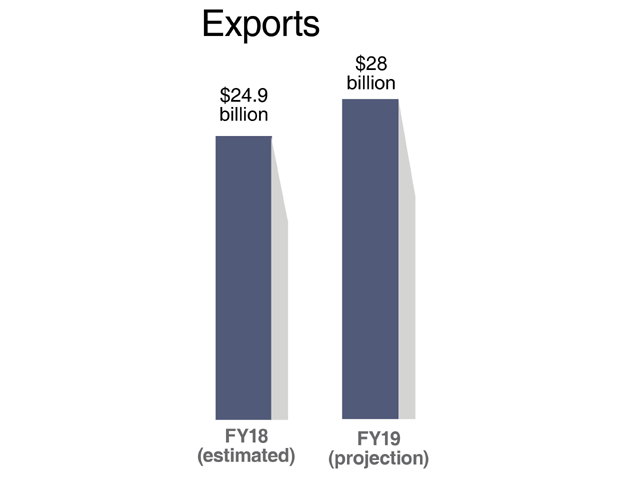
In the budget document, the government also said that it expects exports to grow to $28 billion in the next fiscal year.
However, progress continues to be neutralised by a rising import bill and unrelenting external pressure. While exports registered a growth of 12.2% during Jul-Feb in the outgoing fiscal year, imports rose by 17.3%.
“The Annual Plan’s target of trade deficit for 2017-18 may be exceeded as increase in exports is being outpaced by soaring import bill,” says the Annual Plan for FY 2018-19, unveiled on Friday as part of the federal budget.
Debt repayment, servicing alone to swallow Rs2.2tr
The government’s target was to keep the trade deficit in 2017-18 at $25.7 billion but the actual figure is estimated to stand at $29.4 billion at the close of the fiscal year. The government has attributed the rising imbalance to CPEC-related imports and modest growth in remittances.
The government has also projected next-year’s trade deficit to hover around the $29-billion mark despite remittances crossing $21 billion.
Due to a positive global outlook and improved domestic infrastructure and energy supply, the government has predicted exports to reach $28 billion in 2018-19. But at the same time, the import bill is also expected to continue soaring and reach $56.9 billion next year, implying a trade deficit of $29 billion.

The current account deficit has been projected to be contained at $13.3 billion next year, against an estimated deficit of $15.4 billion in the outgoing year.
The government says the major contribution to increase in exports came from knitwear, readymade garments, chemical and pharma products which were encouraged by the Prime Minister’s Rs180-billion export package. On the other hand, a surge in import bill is attributed to petroleum group with highest share in imports (40.9%). However, imports of machinery, which constituted 19% of total imports, decreased by 3.2% after a constant surge in the past due to CPEC-related projects.
Overall, the government is anticipating an addition of $1.5 billion to reserves by the end of 2018-19.
Remittances grow slow
Overseas workers’ remittances, which have historically served as a neutralising factor in containing the current account deficit, have been on a modest growth trajectory.
Defence budget up by around 20%
“Remittances from Saudi Arabia and other GCC countries registered a decline of 8.7% and 3% respectively, while increase of 43%, 12%, and 2.3% was recorded for EU countries, USA, and UAE, respectively,” stated the budget document. Remittances are expected to reach the $20 billion-mark at the close of 2017-18 while the outlook for the next year is over $21 billion.
A total of 299,206 Pakistani workers went abroad in the first eight months of 2017-18, and another 400,000 are expected to proceed abroad next year. Efforts are also under way to ensure use of formal channels for remittance flow. All these steps, the government believes, will help increase remittances and reduce current account deficit.
Published in The Express Tribune, April 28th, 2018.
Like Business on Facebook, follow @TribuneBiz on Twitter to stay informed and join in the conversation.













































COMMENTS
Comments are moderated and generally will be posted if they are on-topic and not abusive.
For more information, please see our Comments FAQ